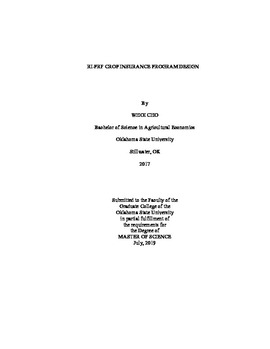| dc.contributor.advisor | Brorsen, B. Wade | |
| dc.contributor.author | Cho, Whoi | |
| dc.date.accessioned | 2020-01-30T19:46:34Z | |
| dc.date.available | 2020-01-30T19:46:34Z | |
| dc.date.issued | 2019-07 | |
| dc.identifier.uri | https://hdl.handle.net/11244/323384 | |
| dc.description.abstract | The Rainfall Index Pasture Rangeland, and Forage (RI-PRF) crop insurance program insures revenues for producers based on rainfall, a single peril. This thesis looks for ways to improve the design of the program as well as makes recommendations for producers who want to participate in the program. Three possible issues are considered i) how well the rainfall index matches actual rainfall, ii) whether the county base values can be made more accurate using spatial smoothing, and iii) optimal choices of RI-PRF crop insurance alternatives for producers. Of particular interest is reducing the number of choices that producers have to make. The rainfall index accuracy is evaluated using actual rainfall from the Oklahoma Mesonet stations. The rainfall index has a strong positive correlation with actual rainfall, but the correlation is lower in the low rainfall areas with fewer rainfall events and fewer Federal weather stations. Each county base value in Oklahoma is imputed using Bayesian Kriging, while the RI-PRF uses only nine regional values. The 77 county base values are more accurate relative to the nine regional base values. Lastly, the expected profit maximizing and risk minimizing strategies were found. The expected profit maximization strategy increases risk by using the maximum coverage level, the maximum productivity factor, and putting all the weight on the low-rainfall winter months. With the risk minimization strategy, the optimal productivity factor is 45%, which is below the lowest productivity factor of 60% that RMA currently offers. The risk minimizing strategy puts all of the weight on growth months of spring and early summer. Reducing the number of choices is suggested. For that, offer only a coverage level of 90%, restrict the bi-monthly index intervals to growth periods, and lower the range of productivity factors. The productivity factor should be renamed "hedge ratio" to better communicate how it is be used if the RI-PRF is to become an insurance program rather than an income transfer program. | |
| dc.format | application/pdf | |
| dc.language | en_US | |
| dc.rights | Copyright is held by the author who has granted the Oklahoma State University Library the non-exclusive right to share this material in its institutional repository. Contact Digital Library Services at lib-dls@okstate.edu or 405-744-9161 for the permission policy on the use, reproduction or distribution of this material. | |
| dc.title | RI-PRF Crop Insurance Program Design | |
| dc.contributor.committeeMember | Lambert, Dayton M. | |
| dc.contributor.committeeMember | Jones, Rodney | |
| osu.filename | Cho_okstate_0664M_16315.pdf | |
| osu.accesstype | Open Access | |
| dc.type.genre | Thesis | |
| dc.type.material | Text | |
| dc.subject.keywords | crop insurance program | |
| dc.subject.keywords | hay | |
| dc.subject.keywords | pasture | |
| dc.subject.keywords | rangeland | |
| dc.subject.keywords | and forage | |
| dc.subject.keywords | rainfall index | |
| dc.subject.keywords | ri-prf | |
| thesis.degree.discipline | Agricultural Economics | |
| thesis.degree.grantor | Oklahoma State University | |
